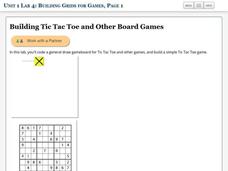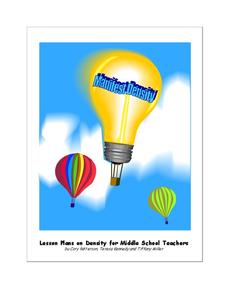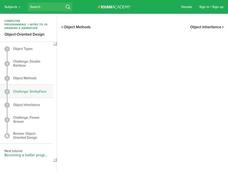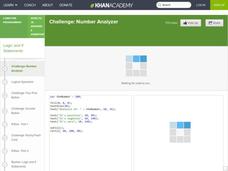Microsoft
Artificial Intelligence
There's nothing artificial about an informative instructional activity. The eighth of nine parts in the Intro to CS with MakeCode series focuses on artificial intelligence. Scholars learn how artificial intelligence is making its way...
National Sailing Hall of Fame
Introduction to Sailboats
The left part of the boat is called what? An informative lesson plan and accompanying slideshow presentation introduce middle schoolers to the terminology and parts associated with a sailboat.
Microsoft
Final Independent Project
Finally ... the final project. As a culminating activity for the nine-part Intro to CS with MakeCode unit, scholars create a program within Minecraft that incorporates skills from the unit. They consider how to survive in the wild and...
Microsoft
Iteration
Learn to code, play, then repeat. The fourth of nine installments in the Intro to CS with MakeCode unit focuses on how to apply iterations in Minecraft. Scholars use the Agent feature and have it dance and build a farm.
Microsoft
Events and Event-Driven Programming
Make the lesson plan an event to remember. The first of nine installments in the Intro to CS with MakeCode series looks at events and event handlers in computer coding. Pupils learn about cause and effect from an offline lesson plan,...
Bonneville
Introduction to the Photovoltaic Effect
Let a video light the way to a better understanding of solar energy. Scholars first learn vocabulary terms related to the photovoltaic effect, solar cells, and electricity. They then watch a video to learn why silicon is often used as a...
Microsoft
Arrays
Zoos are just elaborate arrays. Scholars learn the meaning of arrays and how to create them in Minecraft. Applying this knowledge, they write a program to create a zoo within the game's world. They also complete an independent project...
Microsoft
Conditionals
The conditions are ripe to learn about conditionals. Young computer scientists consider conditionals in their daily lives, then apply their knowledge to computer coding. The fifth of nine parts in the Intro to CS with MakeCode uses...
Beauty and Joy of Computing
Sprite Drawing and Interaction
Discover how to program objects to move on a screen. In the second lab of a five-part unit, each learner uses block instructions to program a sprite to follow their mouse (cursor). They investigate how to use these same block...
Khan Academy
Challenge: H for Hopper
An "H" is just three rectangles when you are trying to draw them on a computer screen. After watching the previous Intro to Drawing video this online programing activity guides young coders to draw the letter "H" on the screen. Help and...
Beauty and Joy of Computing
Building Grids for Games
You can't play Tic Tac Toe without grids. In the fourth lab of a five-part unit, scholars learn how to build grids for games such as Tic Tac Toe. Along the way, they also learn about reporter blocks that perform calculations.
University of Southern Indiana
Manifest Density
There's a lot content packed into the four lessons of this physical science unit on density. From salad dressing to the water cycle and hot air balloons, these lessons engage students in hands-on activities that explore real-world...
Khan Academy
Challenge: Moles in Holes
Move the moles to the holes in this simple coding exercise on using parameters in function calls. The task is broken down for you and the function that draws the mole is already provided. Your job is to add JavaScript code to call the...
Khan Academy
Challenge: SmileyFace
Two smiley faces are better than one. The interactive lesson challenges pupils to use methods to alter a program to make it more efficient. Individuals use the new code to create multiple smiley faces that speak. The engaging activity is...
Curated OER
Geography: Intro to Canada
Young scholars investigate the geography of Canada by analyzing a map of the country. In this North American geography lesson, students identify the 13 provinces of Canada and their locations by examining a Canadian map. ...
Microsoft
Variables
You won't want to replace the resource with anything else. Future computer scientists use Minecraft to learn about variables in computer coding. They engage in several activities to master the variable code block, then apply it in an...
Khan Academy
Project: Make it Rain
Make it rain on your computer screen with this challenging JavaScript programming project. Modify the existing code of one little drop to create a downpour by using arrays and properties of arrays. But why stop there? How about some...
Curated OER
An Introduction to Sensors
Students list as many examples as they can of sensors in their homes and/or automobiles, define sensor and discuss what qualifies devices as sensors, explore human eyes as sensors while watching teacher demonstration, recognize that...
Beauty and Joy of Computing
Building an App
Create your own app with the first lab of a five-part unit. Future computer scientists learn the basics of programming a game application. They use a given software program to design an app where users try to click on a moving...
Khan Academy
Project: Ad Design
Let your young programmers' creativity and programming knowledge shine with this culminating activity. Coders put together everything they know about using text commands, drawing, and animation to create a unique ad. This activity could...
Khan Academy
Challenge: Say Your Name
Practice creating and using functions in a simple JavaScript coding exercise. Move code inside the function definition and then add lines to call the simple function. Adding function parameters and return values are covered later in this...
Khan Academy
Challenge: Number Analyzer
The JavaScript program you create will answer a simple question about a number. Is it positive, negative, or zero? Create a Boolean expression and use conditional if statements to test the value and then print the...
Khan Academy
Challenge: Your First Painting App
Ever wonder how those neat painting applications work? Completing this coding activity will give you some insight. First, starting with a simple function that draws a small circle as the mouse moves around the screen, adjust the function...
Khan Academy
Challenge: Your First Button
Practice using conditional if statements, Boolean expressions, and Boolean operators by programming a user-selected button. This activity guides by using a small program that needs some modifications to work correctly.
Other popular searches
- Intro to Business
- Intro to Poetry
- Intro to European Geography
- Intro to Credits
- Intro to Graphing Equations
- Intro to Language
- Intro to Human Skeleton
- Intro to Business Marketing
- Intro to Biology
- Intro to Frequency Tables
- Intro to Musical Form
- Intro to Computers























